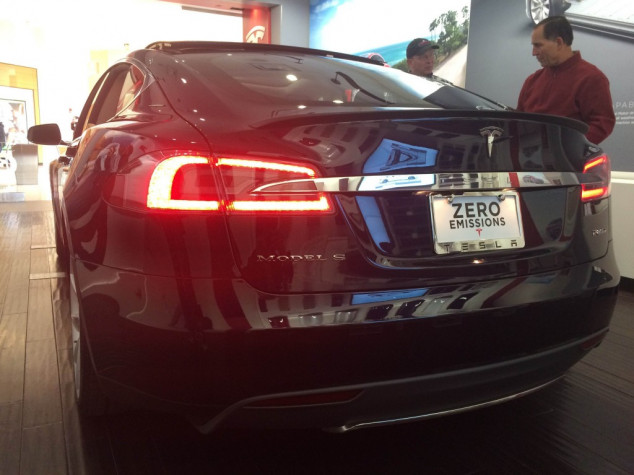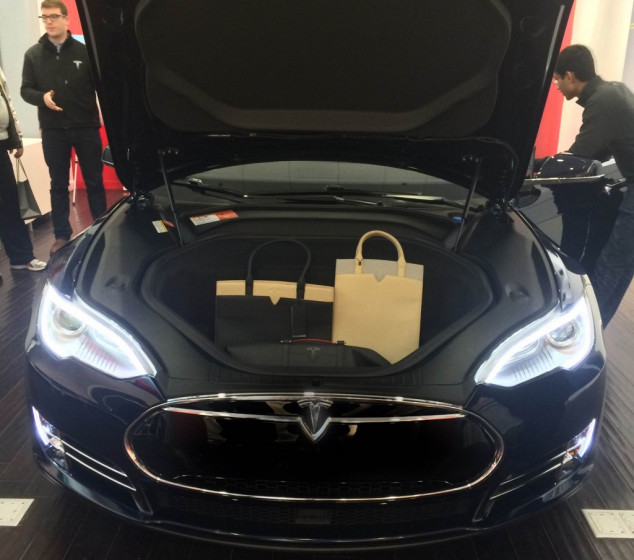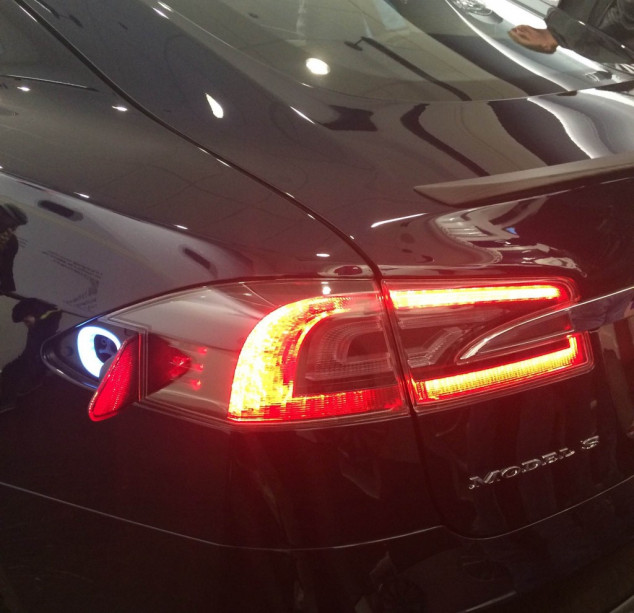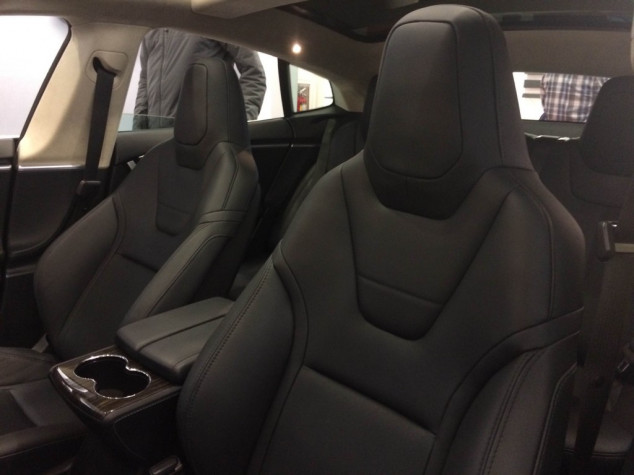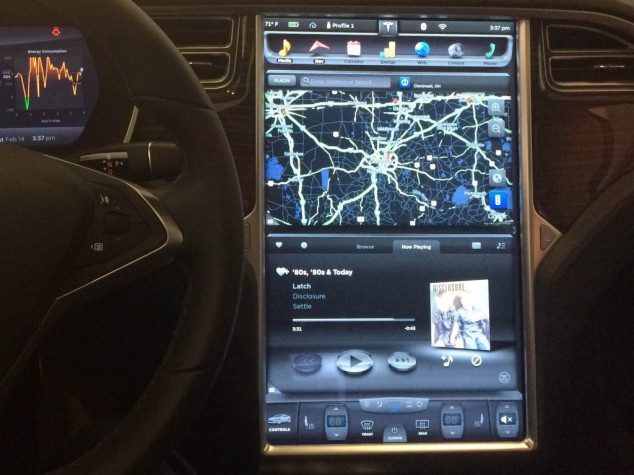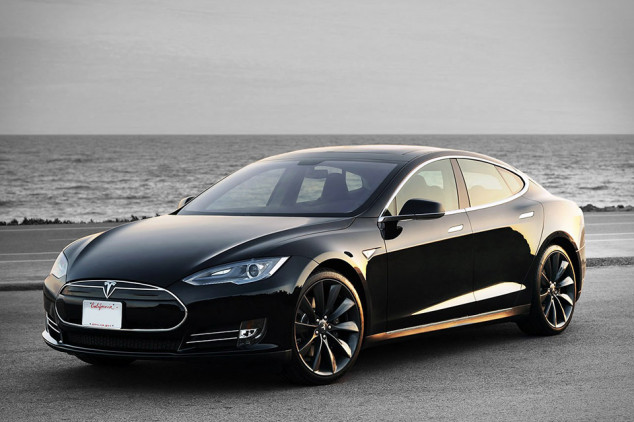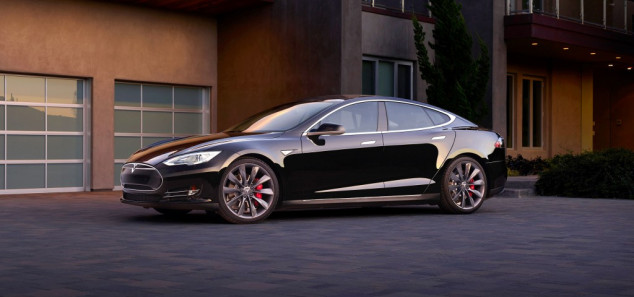The Tesla Model S: Style, Economy, Power
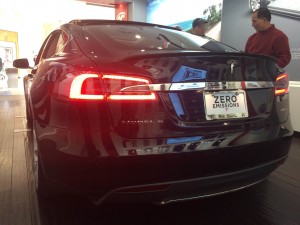 Since 2003, the Tesla Motor Company has been designing and producing purely electric cars. With advances in battery technology and electric motors, the company has been able to flourish the electric car from a tasteless eco-box that could only drive for fifty miles, into a sleek and modern luxury car that is capable of driving across the United States without issue.
Since 2003, the Tesla Motor Company has been designing and producing purely electric cars. With advances in battery technology and electric motors, the company has been able to flourish the electric car from a tasteless eco-box that could only drive for fifty miles, into a sleek and modern luxury car that is capable of driving across the United States without issue.
The Style
In years past, when one pictured an electric car, they saw a Prius-esque machine that has style points that are similar to a dishwasher. Tesla has changed the game with the Model S. After hiring the former Mercedes-Benz designers that ignited the European automaker’s transformation, Tesla went from cars that looked like they were designed using only a pen and a ruler to creating the sleek and prestigious machines we are familiar with today.
The Model S is a completely new design, featuring clean and modern lines, contrasted by vibrant color options and beautiful interior design. When you step near the vehicle, it detects the presence of the key in your pocket and produces the receding door handles which sink into the body for better aerodynamics. As you place yourself in the perforated napa leather seats, you notice a fully glass roof with a sunroof that can be set to open a specific percentage. There is also tasteful integration of chrome and walnut trim, along with ergonomically designed storage compartments.
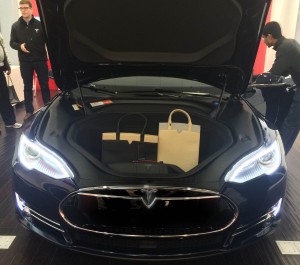
Tesla Model S front storage space.
The main thing one notices, though, is the amount of space. With electric motors taking up nearly a quarter of the space of the average internal-combustion engine, Tesla has been able to optimize the space to create a comfortable sedan that has five seats for adults, as well as an option for rear-facing children’s seats towards the back of the car, creating a seating option for seven people in an average-sized sedan. When you pop the hood, you find the exact same thing as you would if you popped a Porsche’s hood: cargo space. And, if you pop the trunk, you find the same thing as you would in a Toyota Camry: cargo space.
There are so many subliminal styling accents that make this vehicle sleek but practical, from the integration of the electric plug into the taillight, to the tiny little wiper fluid container in the back of the front trunk, one can see that this automobile was designed very well.
The Technology
After being up close and personal with a Tesla Model S, I have learned a lot about the standard technology available in the automobile. It has replaced all standard buttons that would be on the center console with a very large touchscreen, featuring a web browser, navigation, online radio streaming, and data taken about your driving. The screen also controls all climate control, including fan speed and defrosters.
The most notable feature of the automobile, however, is the integration of Mercedes-Benz’s driving assist program. Because this car was designed in tandem with the new generation of the top-of-the-line Mercedes-Benz S-Class, the Model S features many of the same styling cues and tech features that are found in an S-Class, the most major being the driving assist program.
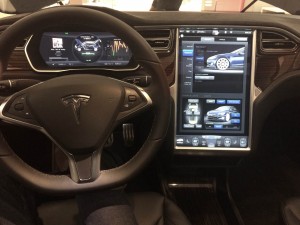 This highly advanced system utilizes several radar sensors, as well as cameras, surrounding the car in order to keep the vehicle from drifting out of its lane. These various radar systems are also used to lock onto a car that is ahead of you, so when it speeds up, you speed up, and vice-versa. These features allow for an effective autopilot system, so long as the person in front of you is travelling to the same destination as you.
This highly advanced system utilizes several radar sensors, as well as cameras, surrounding the car in order to keep the vehicle from drifting out of its lane. These various radar systems are also used to lock onto a car that is ahead of you, so when it speeds up, you speed up, and vice-versa. These features allow for an effective autopilot system, so long as the person in front of you is travelling to the same destination as you.
The Power
After a few years of successful production, CEO Elon Musk personally requested the development of a performance model, which was developed very quickly and is known effectively as the Model S P85D.
To most, this may seem like a bunch of extra characters tacked onto an already bland name, however, they hold a specific meaning. The P stands for performance motors, which develop over 340 more horsepower than the standard model, already packing a hefty 350 as is. The sheer acceleration of these motors is inconceivable, as most are used to the split-second delay caused by an internal-combustion engine where the power is delivered from the engine to the transmission. Contrasted by an electric automobile, which integrates the engine and the transmission, the Tesla single-speed “automatic” causes the acceleration of the vehicle to post a 0-60 mph time of 3.1 seconds, beating a brand new Ferrari 458 by almost half a second.
The 85 stands for the long-distance 85 KwH battery that is featured in the car, extending the range of the vehicle while still keeping it practical.
Finally, the D aspect of the nameplate refers to the dual motor system, one at each axle, which allows the vehicle to have a very responsive four-wheel-drive system that can place the power of the machine onto the road much better.
My personal favorite aspect of the vehicle’s performance is the option you have for it. In the multi-touch display, there is a vehicle option for performance that is a simple switch with two options: sport and insane. This nods to the vehicle’s already sporty nature, but touches on the millennial flair that seems to inspire words such as “insane” to depict something positively.
The Economy & Environment
One of the main concerns with buyer of a Tesla is that it will run out of juice and will take the whole rest of the day to recharge, or the batteries will eventually lose their luster and will cost an arm and a leg to replace.
While most of this was true in the old days, the new electric car is here to put all those concerns to rest. Tesla supplies several different adapter cords that connect to any type of outlet, allowing for faster charging as the power outlet allows for more energy. However, plugging the car into an average three-pronged socket at your house is going to take a long time, as those were designed to power desk lamps, not cars.
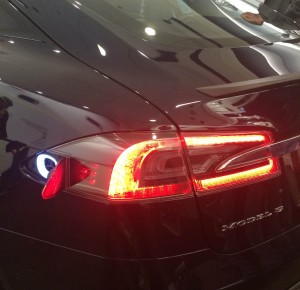
The Tesla’s sleek charging connector fits perfectly into the contour of its taillight.
The solution Tesla has given is what is known as the “Supercharger,” a network of gas station-like facilities that are spread all over the world, with no more than 150 miles between each one. With high output chargers available here for free, exclusively to Tesla owners, cars can be charged from a 10 mile range to a 200 mile range in around 20 minutes, which is in stark contrast to the original 4 hours from the Tesla high-output wall charger.
Although a 150 mile trip to the gas station seems like a long way (the nearest local one is in Dayton), Tesla still provides home chargers. These, however, are on your own electric budget, but with one kilowatt/hour costing a little under eight cents, that means a Tesla Model S can be filled up for around 7 dollars.
The Future
Tesla has stood up before the knock-out bell has rung again and again. But, the future of the company, which has now established itself as a contender in the global auto market, is the real question to which everyone wishes to know the answer.
Although the next vehicle set for production is the Model X, a strange crossover-SUV with the same doors as the DeLorean in Back to the Future, Tesla’s original business plan depicted a developmental system featuring the terms “RedStar,” “WhiteStar,” and “BlueStar.” These were the terms for the cars Tesla intended to produce in order to establish itself as a luxury American carmaker, in a world where the terms “American” and “luxury” do not often go together as well as if one was to substitute “British” or “German” for “American.” The first vehicle was the RedStar, or as some might be more familiar with, the Tesla Roadster, intended to be “Low volume, high price.”
The RedStar was followed by the Model S, or “WhiteStar,” intended to be “Mid volume, mid price.” The BlueStar’s production name has been revealed as the “Model 3,” a smaller version of the Model S with an appropriate range of around 200 miles and a price of around $35,000, completing the final part of Elon Musk’s original business plan for the Tesla company to produce a vehicle that was “High volume, low price,” a vehicle which many have considered might be to electric cars what the Ford Model T was to gasoline cars: an affordable way for the mass population to enter into the next generation of motoring.




